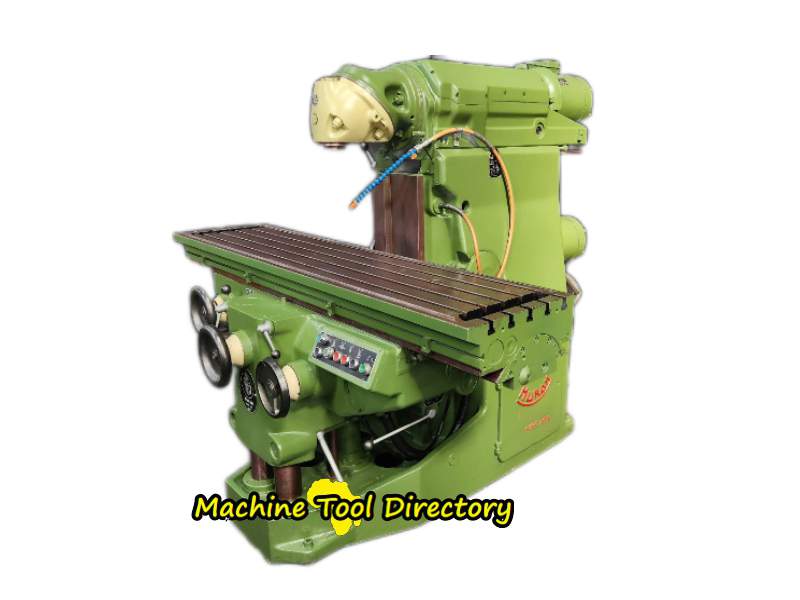The Ultimate Guide to Finding the Perfect Used Milling Machine
Overview of a Milling Machine
If you are in the market for a used or second hand milling machine, this guide will assist you through the process by helping you understand the machine and its features, enabling you to select the correct machine for your requirements.
Purpose of Milling Machines in Metalworking
Milling machines are machine tools used for precision manufacturing designed to remove material from a workpiece through various processes, including face milling and end milling. They are essential for creating complex parts used in many industries, such as automotive manufacturing, construction, and precision engineering workshops. Whether you are machining metal components for industrial equipment or creating intricate mechanical parts, a reliable milling machine is a necessary tool in your workshop.
The quality of the final product in milling is significantly influenced by the type of milling machine used. Different designs and configurations affect not only the precision of cuts but also the overall efficiency and effectiveness of the machining process.
Basic Overview of How a Milling Machine Works
The working principle of a milling machine involves rotating cutting tools that remove material from a workpiece, which can also be moved during operation. Here is a basic explanation of the milling process:
1. Workpiece Positioning: The workpiece is securely mounted on the machine's table.
2. Tool Selection: An appropriate cutting tool is selected based on the material and desired outcome.
3. Cutting Action: The rotating cutting tool moves across the workpiece, removing material in a controlled manner. Both the tool and workpiece may be moved depending on the operation.
4. Precision Movement: The machine's 3 axis (typically X, Y, and Z) allow for precise positioning and movement of both the tool and the workpiece.
Understanding the Different Types of Milling Machines
Vertical Milling Machines
- Vertical spindle orientation
- Ideal for face milling, slot cutting, and creating vertical surfaces
- Commonly used in smaller workshops and for less complex machining tasks
Horizontal Milling Machines
- Horizontal spindle orientation
- Excellent for heavy-duty cutting and working with larger workpieces
- Preferred in industrial manufacturing settings
CNC Milling Machines
- Computer Numerical Control (CNC) technology
- Provides high precision and repeatability (though actual precision can vary based on machine quality and setup)
- Allows complex, multi-axis machining operations
- Suitable for advanced manufacturing requirements
Understanding the Difference between Conventional & Universal Milling Machines
Conventional Milling Machine:
- Typically has a fixed table orientation
- Limited to either horizontal or vertical milling configurations
- Simpler design with fewer adjustable components
- Best suited for straightforward, single-plane machining operations
- Less expensive and more common in smaller workshops
Universal Milling Machine:
- Features a swiveling table that can be tilted at various angles
- Allows machining of complex, multi-dimensional parts
- Can perform both horizontal and vertical milling operations
- Equipped with a dividing head for creating gear teeth and complex geometric shapes
- More flexible and adaptable for precision engineering tasks
The key distinction is that while conventional machines are primarily single-orientation, universal machines can perform more complex multi-angle machining tasks. However, many modern conventional machines can also be equipped with additional features that enhance their versatility.
Key Features of Milling Machines
Important Specifications to Consider
When evaluating milling machines, consider these specifications:
- Spindle speed range
- Table size and movement capabilities
- Axis travel and positioning accuracy
- Compatibility with various cutting tools
- Power requirements and motor specifications
- Cooling systems (for heat management)
- Tool changers (for efficiency in CNC applications)
Common Applications
Milling machines are commonly used for:
- Precision part manufacturing
- Prototype development
- Complex mechanical component creation
- Automotive part machining
- Custom equipment fabrication
Benefits of Buying a Used Milling Machine
Buying a used milling machine offers significant cost savings compared to new equipment. This is particularly advantageous for:
- Small to medium-sized workshops
- Startups and emerging manufacturing businesses
- Educational and training institutions
Key Considerations When Buying a Used Milling Machine
Technical Evaluation
When assessing a used milling machine, consider:
- Machine condition
- Alignment and calibration status
- Availability of replacement parts
- Ensure support from manufacturers or third-party suppliers for older models.
Operational Requirements
Consider your operational needs regarding:
- Intended material types
- Required precision levels
- Production volume
- Specific project needs
Environmental Benefits of Buying Used Milling Machinery
Buying used machinery contributes to:
- Reduced industrial waste
- Lower carbon footprint (due to reduced resource consumption compared to manufacturing new machinery)
- Extended equipment lifecycle
- More sustainable manufacturing practices
Selecting the right used milling machine requires careful consideration of your specific manufacturing requirements, budget constraints, and long-term operational goals. By understanding the different types, features, and potential benefits, you can make an informed decision that enhances your manufacturing capabilities.
Click here to view our extensive range of Used Milling Machines available for sale ex stock
